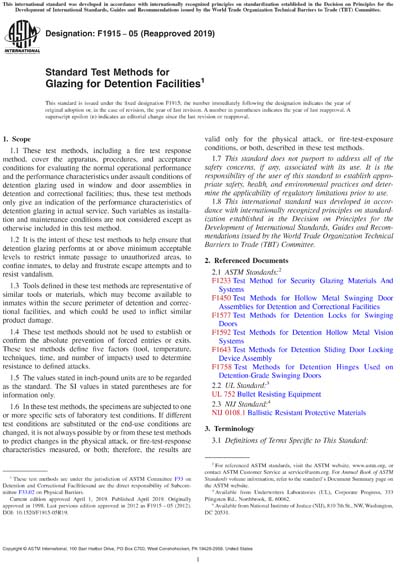Most recent
ASTM F1915-05(2019)
Standard Test Methods for Glazing for Detention Facilities
1.1 These test methods, including a fire test response method, cover the apparatus, procedures, and acceptance conditions for evaluating the normal operational performance and the performance characteristics under assault conditions of detention glazing used in window and door assemblies in detention and correctional facilities; thus, these test methods only give an indication of the performance characteristics of detention glazing in actual service. Such variables as installation and maintenance conditions are not considered except as otherwise included in this test method.
1.2 It is the intent of these test methods to help ensure that detention glazing performs at or above minimum acceptable levels to restrict inmate passage to unauthorized areas, to confine inmates, to delay and frustrate escape attempts and to resist vandalism.
1.3 Tools defined in these test methods are representative of similar tools or materials, which may become available to inmates within the secure perimeter of detention and correctional facilities, and which could be used to inflict similar product damage.
1.4 These test methods should not be used to establish or confirm the absolute prevention of forced entries or exits. These test methods define five factors (tool, temperature, techniques, time, and number of impacts) used to determine resistance to defined attacks.
1.5 The values stated in inch-pound units are to be regarded as the standard. The SI values in stated parentheses are for information only.
1.6 In these test methods, the specimens are subjected to one or more specific sets of laboratory test conditions. If different test conditions are substituted or the end-use conditions are changed, it is not always possible by or from these test methods to predict changes in the physical attack, or fire-test-response characteristics measured, or both; therefore, the results are valid only for the physical attack, or fire-test-exposure conditions, or both, described in these test methods.
1.7 This standard does not purport to address all of the safety concerns, if any, associated with its use. It is the responsibility of the user of this standard to establish appropriate safety, health, and environmental practices and determine the applicability of regulatory limitations prior to use.
1.8 This international standard was developed in accordance with internationally recognized principles on standardization established in the Decision on Principles for the Development of International Standards, Guides and Recommendations issued by the World Trade Organization Technical Barriers to Trade (TBT) Committee.
ASTM International [astm]

